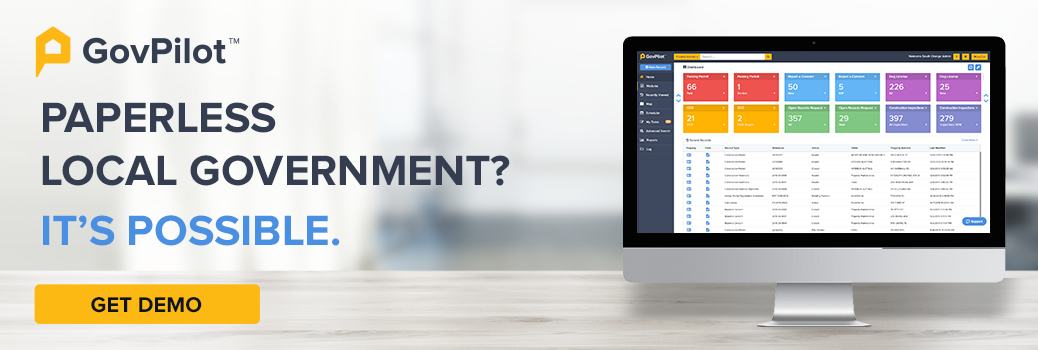Local health departments have thousands of public health records to store, from business inspection notes to health licenses, and everything in between. Without the right approach to health department data storage, local health departments may face challenges with data privacy, unintended communication silos, or inefficient processes.
Additionally, as technology advances and the cloud expands, public health departments may need to capture and share large amounts of data from cloud-based devices, like wearable health trackers, exercise equipment, and applications used to run inspections, permits, and program enrollment.
Ensuring local health departments and their partners have access to quality public health data is paramount to strong public health responses, breaking down communication silos, and improving community health overall.
In this article, we’ll cover what public health data storage looks like, some of the challenges with existing health data management systems, and the benefits of moving public health data storage to the cloud.
What is Public Health Data Storage?
Public health data storage refers to the collection, management, and preservation of public health records created by public health departments. Public health data storage, sometimes referred to as health data management, organizes digital health records and data. Modern storage technology provides vital tools for monitoring public health, identifying trends, and making decisions.
With GovTech, local health departments collect various kinds of data, depending on the program, policy, or regulatory requirement. Types of government health data include health inspection reports, permits and licenses, claims, medical records, program enrollment data, vital records, infection rates, and more.
Public health data can be used by health departments and public health directors in a variety of ways, such as identifying barriers to care in a community, improving how health inspections are conducted, and identifying public health risks.
Challenges with Paper-Based, Legacy Public Health Data Storage Approaches
Many legacy public health data storage solutions are paper-based or housed in on-premise servers. Although a common practice for many local public health departments, legacy systems and paper-based methods come with a few challenges.
Storing public health data this way can introduce privacy and cybersecurity issues, communication silos, and inconsistent data standards. These challenges can also lead to decision-making without a complete understanding of a community’s needs or public health issues.
-
Privacy and cybersecurity issues
Promoting and protecting the health and privacy of individuals and communities is critically important for local health departments. Paper-based public data storage approaches are susceptible to unauthorized access, damage, loss, and theft. There are few safeguards in place to prevent many of the threats associated with paper-based data storage.
Legacy on-premise servers are secure within network perimeters, but with remote work becoming the new normal, network perimeters are now expanding outside the bounds of on-premise server networks. Because of expanding workforce perimeters and attack surfaces, on-premise servers are now more susceptible to cyber threats than ever before.
Consider these Local Government Cybersecurity Tips and Considerations for the Cloud vs. On-site Servers for Municipalities.
-
Communication silos
Paper-based data storage approaches can often lead to communication silos between departments and prevent efficient data sharing between organizations. The steps involved to share paper-based data are also administratively burdensome.
Similarly, on-premise legacy systems are typically harder to access without proper authorization. Granting access to on-premise servers requires significant paperwork and can take days or weeks to approve. Data silos force departments to work in isolation, leading to duplication of efforts, inefficient data sharing capabilities, short-sighted decision-making, and a lack of transparency between entities.
Learn more about Modernizing Your Local Government Communications Strategy and Coordinating Health Testing as a Local Health Department.
Data standards often vary between different local health departments and community health organizations. This inconsistency makes data sharing and analysis challenging, and can lead to ineffective decision-making.
If multiple organizations are tracking a metric using different data standards, analysis of this data becomes much more complex and time consuming. Using inconsistent data can also lead to inaccurate reporting and higher compliance risk.
Benefits of Moving Public Health Data Storage to the Cloud
1. Higher levels of cybersecurity
Cloud computing providers often use advanced security measures, like data encryption, to provide end-to-end protection of sensitive data. Cloud security is also a specialized field of cybersecurity focusing on securing cloud data against government cyber threats and data breaches.
With GovPilot ensuring regular data backups and disaster recovery capabilities, storing public health data in the government cloud ensures data is secure and can be quickly and easily restored in the event of a disaster or system failure.
Certain types of cyber threats, like insider threats, are also better identified and isolated in a cloud environment. Although human errors may still occur, cybersecurity teams have more advanced tools to address these errors quickly if data is stored in the cloud.
Here are Cybersecurity Training Essentials to Teach Government Workers to prevent a breach due to human error.
2. Increased efficiencies and streamlined workflows
As soon as health inspectors submit their field health inspection reports, the data is automatically stored in the cloud and can be easily accessed from anywhere. This can speed up approval workflows and even the permitting process.
Storing public health data in the cloud not only benefits public health employees, but also businesses waiting for inspection updates or permit approvals. Everything from open records requests to collecting application fees and health violation fines is streamlined once public health data is stored in the cloud.
Learn more about Online Government Fee & Fine Collection.
3. Access to data insights and dashboards
Embracing cloud-based health department software enables public health departments to access a full spectrum of data insights that can be used to improve programs, inform future budgets, create more accurate reports, and develop more effective policies.
Visualizing public health data can also uncover community health patterns or business shortcomings that were not previously visible, leading to improved decision-making and better outcomes. Tracking certain metrics, like permit release times or health inspection approval rates, are helpful to improve programs and business operations.
Here are more tips for health department leadership for collecting data and using it for informed decision-making:
- Government Analytics: Making Informed Decisions Using Government Data
- Setting and Monitoring Local Government Key Performance Indicators
4. Improved data-sharing
Storing public health data in the cloud promotes better communication between multiple departments, leading to less overlap, better resource distribution, and everyone working on the same page. For instance, health inspection reports can easily be shared with other departments that might be involved in the approval process.
Cloud-based data storage also ensures better data-sharing between local health departments, healthcare providers and community-based healthcare organizations for better public health responses. In the event of a public health emergency, having the ability to share data between organizations is critically important to plan a concerted response.
Digital storage over paper is an important step towards Sustainable Public Healthcare.
5. Ease of training
When public health data is readily available on the cloud, training new and existing staff becomes simpler and less resource intensive. Training can be done remotely with online training videos, tutorials, and webinars, which staff can access remotely at their own pace.
New data dashboards are easy to use and simple to learn, so staff can quickly adapt to the new system, gain access to data, and increase productivity.
Here’s How to Onboard and Train Public Officials on Government Software.
How Local Public Health Departments Can Go Digital
Moving public health data storage to the cloud is an important and necessary step for local public health departments to strengthen cybersecurity, increase data accessibility, and improve workflows.
Storing public health data in the cloud opens a new realm of possibility for health departments to improve public health responses, streamline the permitting and inspection process, and develop more effective policies. With data readily accessible in the cloud, local health departments can improve transparency and provide better service to the public.
The benefits of cloud-based data storage ensure that local public health departments can operate more efficiently and effectively, leading to better outcomes and improved public health.
To learn how GovPilot government software can help streamline the inspection and permitting processes for health departments, book a free demo.
Public Health Data Management FAQs
1. What is the Public Health Cloud?
The public health cloud is a government data storage method for local health departments to store critical public data. Documentation pertaining to health inspections, property records, pet licenses, health testing, animal control and impounding, etc. are all stored digitally and accessible from anywhere by relevant health officials.
2. Why Should Health Inspections Operate From the Government Cloud?
Even beyond the cybersecurity benefits that come with storing health data in the cloud, there are many other benefits to moving health inspections to a cloud-based capacity. Customizable forms can be created for various inspection types, from retail food inspections to aquatic facility inspections and beyond. These forms can be efficiently completed in the field using a government mobile device, and will be made instantly accessible alongside relevant property records upon completion of the inspection. That saves your department time and money to be utilized elsewhere.
3. What are the Benefits of Health Department Software?
Health department software moves all public health data to the cloud for increased cybersecurity and accessibility. Additionally, online health permit and licensing applications will allow citizen services to be completed from your government website. Health inspections can be completed via a phone or tablet. Insightful data can be collected across health workflows to make informed decisions in the health department.
4. What is Public Health Data Management?
Public health data management is the process of storing key data in the local health department. Traditionally, health data was stored using physical paper or physical, on-site servers. In more recent memory, many local health departments have moved to the cloud as a means for more cyber secure health data management and automated storage of and access to health records like permits, licenses, and inspection forms as soon as they are filed.
Read more of the latest government trends:
- Promoting Equity in Local Government
- Modern Local Code Enforcement Strategy
- Encouraging Civic Engagement from Your Citizens
- Tips for City Managers & Administrators to Consider
- How Do Online Permitting Systems Work?
- NJDOH Local Health Department Grants
- Actionable Tips for City Managers & Administrators
- Continuity of Government: Government Procedures During a Crisis
Sources










